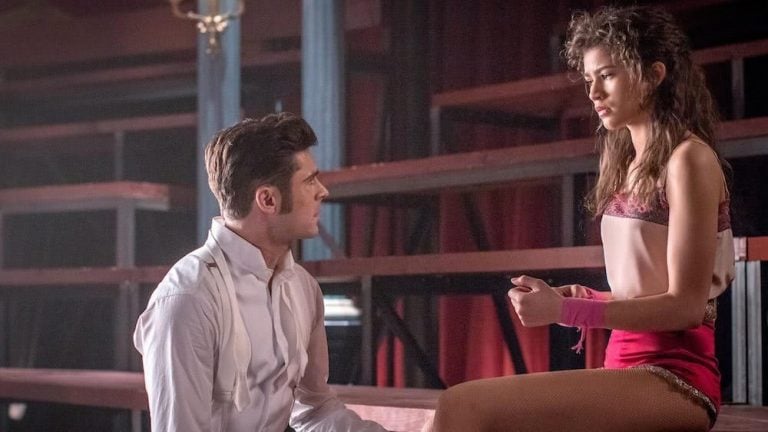It’s a Sunday afternoon sing-along session of The Greatest Showman in a suburban Brisbane megaplex, and I can’t remember the last time I witnessed a response like this to a film.
Present is the type of cross-section that most films desire to grab: teenagers, grandmothers, couples, parents charged with groups of children and handing out pre-prepared snack bags. Most people here have seen the film once, twice, and more times before now, as will soon become apparent, but the palpable excitement rivals the hotly anticipated mystery of the most secretive Star Wars movie.
Sing-along sessions are usually a source of side eye directed at overly enthusiastic participants, but not this time. Nervous giggles ripple through the crowd when the first notes blare. An over-excited few make a false start on the first words. We warm up for out big moment. Then, we take flight.
“Ladies and gents, this is the moment you’ve waited for,” Hugh Jackman and the audience croon in unison. The audience doesn’t stop buzzing for nearly two hours, singing out every line, clapping at the end of songs like Jackman himself was sliding on his knees up the front, gasping and cheering alternately with each kiss.
We have practiced our best renditions of ‘Never Enough’ and ‘This Is Me’ in showers and cars, and now, with a triumphant exhale, we realise that the moment of being able to belt the hell out of the songs amongst receptive company is nearly here. To paraphrase: it’s everything you ever want, it’s everything you ever need, and it’s here right in front of you.
The plot is scant, and spoken words are a waste of energy Showman doesn’t have time for.
“It’s been a long time since I’ve seen a film that brings me such unadulterated joy,” Stephanie, a filmmaker and editor says. She has seen Showman four times – three times in a normal session, once in a sing along.
Love Film & TV?
Get your daily dose of everything happening in music, film and TV in Australia and abroad.
“The music, the heart in the story, the ‘spectacle’ element; it always leaves me feeling happier than when I came into the cinema.”
Rujeela, who has just seen it for a third time, agrees with her. “The sing-along was such a fantastic experience, because most of the people there had already seen the movie and loved the music and were so passionate and loud and happy. It felt like going to see your favourite band in concert.”
“It unites everyone who has ever felt out of place and it embraces differences,” says Cecilia, who has seen the film three times, but doesn’t think “that is enough”.
“I saw it in London one night with my friend and we walked out mesmerised. The damn Greatest Showman soundtrack; it basically became the soundtrack of our trip. Then when we were in Glasgow it was really gloomy and snowing a lot and we weren’t up to walking around, we saw the movie again. We screamed when Hugh Jackman came in with a husky voice in the first few minutes.
“Flashforward to me being back in Australia and dragging my boyfriend to another session. He hadn’t seen it before, but I wouldn’t stop talking about it and he reluctantly agreed to seeing it. He loved it, thank goodness.” She laughs. “It would have been an issue had he not liked it. It makes me feel hopeful.”
For a film that mere months ago looked like an expensive passion project gone wrong, this is quite some recovery. So how did we get here?
I saw the film at a premiere in December, loving its impeccably choreographed exuberance and joy, but unsure whether it would find a home with an audience. My worry: are we too cynical for something that’s basically been ripped from the screens of 1952 and plopped into 2017?
The Greatest Showman has the type of disregard for history that most are resistant to these days, proving a loosely P.T. Barnum flavoured musical instead of an autobiography that confronts the ugly reality of his circus. Critics were mostly uncaring or negative. “This ersatz portrait … is all smoke and mirrors, no substance” said The Hollywood Reporter’s David Rooney.
“The Greatest Showman takes a billion of the world’s oldest story beats and refashions their prefab emotions into something that feels like it’s being projected from another planet” agreed Indiewire’s David Ehrlich. And Ehrlich’s is one of the more positive reviews; he uncovers a hint of what makes the film work.
Over two months after release, The Greatest Showman hasn’t left the top ten at the box office in Australia, the United States, and the United Kingdom. Instead of starting big, it has only grown through word of mouth. It’s an amazing and rare success that hasn’t so much come out of nowhere, but been a fantastic against-the-odds victory.
The records it has broken are numerous, so here’s a small selection. It opened in the US in fourth place with under $10 million on Friday December 20, a reception that Fox’s chairman told The Hollywood Reporter left her feeling “gut-punched” and as though the film’s journey would soon be over. But then, it held on.
The soundtrack, described as “unbearably amazing” by someone I talked to, is only the fifth soundtrack in the last ten years to spend multiple weeks at the top of the Billboard charts. Figure skaters at the Winter Olympics simply couldn’t let it pass by.
Covers and dance routines have flooded YouTube, and lead song ‘This Is Me’ has become an anthem, helped by an emotional behind the scenes video of star Keala Settle. Even as the Showman’s main competition, Star Wars: The Last Jedi, halved its gross weekly, closing out February at number 28 at the box office, the musical has only increased – or barely declined – every weekend. The film even did the unheard of in its second weekend outing, nearly doubling its gross. Opening at a soft third place on Boxing Day in Australia, it has remained steady since, making history both here and in the UK by taking the top spot in its sixth week.
Having defied expectations and made records, and currently showing more staying power than even Titanic, it’s a mystery as to what the end gross will be when the film takes its final theatrical bow (no sign of that yet).
In the US, it has already surpassed La La Land, which ended its run at nearly $500 million worldwide, to become the fourth biggest musical of all time. It’s a fact made more remarkable by the market currently. Films quickly clean up with dizzying openings and vanish, with a hotly anticipated release like the Last Jedi making $1.3 billion and disappearing in the space of ten weeks, audiences increasingly proving uninterested in 3D and other gimmicks.
The film has more in common with Singin’ In The Rain, The Greatest Show On Earth, and the escapist hit parades of the WWII era than La La Land.
In contrast, Showman is still boasting sold out sing-along sessions across the world, full of wholehearted whooping and cheering; a rare film that can be seen by anybody. “The lesson is that certain audiences are underserved, particularly in a world where Disney is delivering all these monster tentpoles,” said producer Peter Chernin to The Hollywood Reporter.
With the exception of the radio-ready soundtrack, the film has more in common with Singin’ In The Rain, The Greatest Show On Earth, and the escapist hit parades of the WWII era than La La Land. Showman doesn’t attempt to update to the mindset of 2017 or reinvent its formula, and it doesn’t have a hint of the sly winking at the audience that defined that film and distanced viewers from the characters.
The plot is scant, and spoken words are a waste of energy Showman doesn’t have time for. Rather, it will do absolutely anything it can with its endlessly energetic cast – moonlit dances on rooftops, romantic duets on trapezes, cover-ready power ballads – to make you smile. It’s consciously doing something radical and unseen; something that has been sucked from the multiplex in the age of mega-serious superhero franchises, horror, and disaster movies. But viewers are no less hungry for what Showman has to offer: unfiltered joy and a communal experience.
It’s a success not entirely dissimilar to one that took place over 50 years ago. In 1965, after expensive gimmicks, a series of disastrous films, a steady drift to television, and declining attendances (sound familiar?), 20th Century Fox brought itself back from the brink with The Sound Of Music. Sound familiar? While more expensive than the quickies the studio had been producing in a bid to make some cash (it cost a little over $8 million, which equates to around $63 million now) and dismissed by critics (iconic critic Pauline Kael called it “the sugar-coated lie people seem to want to eat”), it was a hit in the way the studio hadn’t seen since the 1950s.
It opened in a limited number of cities around the United States, playing only two shows a day with allocated seating and costlier than average tickets. Despite this, after four weeks, playing in only 131 theatres, it took first place at the box office. It stayed there for the next 30 weeks. Billed as “the happiest sound in the world”, like Showman it thrived on repeat viewings, with some towns in the US selling more tickets than there were inhabitants. A year later, it was the highest grossing film of all time. It didn’t leave theatres until the 1960s became the ’70s.
Viewers are no less hungry for what Showman has to offer: unfiltered joy and a communal experience
“(Before) I never really understood the impulse to rewatch a film as many times as possible, over even the shortest period of time. This is definitely new to me,” says Elena, a critic and editor who attended the world premiere of the sing along version in London.
“The film is such a spectacle – in the sense of a full-body experience. The songs are so good, I listen to them all the time, but they are even better with the image. I think the way in which the film itself embraces both its more ridiculous parts and its genuinely gorgeous elements with the same enthusiasm and humour is extremely seductive and thrilling. It’s such a wild ride, but always a beautiful and earnest one. It almost transcends notions of good and bad, to reach into sublime fun.
“[It’s] such an unruly beast. At the first screening, I was mostly baffled. By the second viewing, I knew the lyrics of the songs already, and being able to follow with the characters was a whole other kind of thrill. At my third viewing, I became extremely involved in the emotional story of the characters, which itself is at the core of the songs, and I cried. The fourth viewing was a singalong, and that was again something else entirely.
“Everyone in the room was just so happy and so free: there was this amazing energy where everyone screamed the songs of course, but also very much had fun with the more ridiculous aspects of the film. People would actually respond to what was going on. It was amazing!”
“For example, when Jenny Lind was about to kiss Barnum on the lips in front of the audience of her last show, everyone of course already knew this was going to happen, and we all anticipated the moment so much. There was a huge crescendo of sound in the room; then everyone screamed ‘No!’ when the kiss happened. It was very playful, but never mocking. It’s hard to believe a film like this can exist. And it’s just so funny it does!”
As with the success of La La Land, there are questions as to whether the success hints at an untapped market for musicals. Few and far between but proven box office magnets, some say that there is a hunger for more music at the multiplex, while others say that musicals are too individual to make such a distinction.
Back at the Brisbane multiplex, as the credits roll, my audience continues singing ‘This Is Me’ and ‘Rewrite The Stars’, and a crowd of girls start dancing in front of the screen (a sight that has been repeated at many sing-alongs), I wonder if Showman’s success shows something else audiences are looking for that has mostly disappeared: an unambiguously joyful and uncynical escape, and one that can be shared.
“I’ll admit when I went to go see the movie (the first time) I had no clue what it was about. The movie took my expectations and completely blew me away,” Rujeela says. “The next time I saw it I convinced my friend to go watch it. My favourite part was getting to watch her face light up the way mine did.”
The Greatest Showman is still playing at selected cinemas across Australia


































